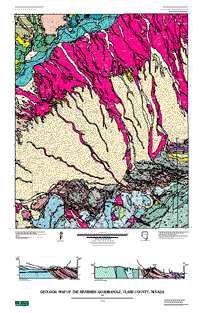
The Riverside quadrangle lies along the eastern edge of the Basin
and Range province in southeastern Nevada. The map area extends from
the Virgin Mountains northward to the edge of Mormon Mesa, and is traversed
in its northern part by the narrow, incised valley of the Virgin River.
Most of the map area lies in the southwestern part of the Virgin River
depression (Bohannon and others, 1993).
The Virgin River depression, about 28 km wide, lies between the
Mormon Mountains (maximum altitude 2,260 m) and East Mormon
Mountains to the northwest and the Virgin Mountains (maximum altitude
2,356 m) to the southeast and east. The Mormon Mountains are within
the Sevier thrust belt, where a thin sheet of allochthonous lower Paleozoic
strata tectonically overlies an autochthon consisting of Paleozoic and lower
Mesozoic rocks. Detachment faulting associated with middle Miocene
extension has produced strong local tilts, exposing Precambrian rocks at a
few localities (Axen and others, 1990), notably in the East Mormon
Mountains. The Virgin Mountains are entirely east of the thrust belt and
they contain a complete, but dismembered section of autochthonous Paleozoic
and Mesozoic strata. Strong uplift in the Virgin Mountains associated
with middle Miocene extension and strike-slip faulting has resulted in
the exposure of Proterozoic crystalline rocks along the entire southwest
edge of the Virgin River depression. Proterozoic rocks in the Riverside quadrangle and surrounding areas
have been mapped and studied by Beal (1965). Where possible, we have
tried to conform to his terminology. Parts of the rock descriptions used
here, primarily mineralogical and textural information, are taken from
Beal (1965).
|
|
Part or all of this report is presented in Portable Document Format. The latest
version of Adobe Acrobat Reader or similar software is required
to view it. If you wish to download the latest version of Acrobat
Reader free of charge, click here.
|
|

